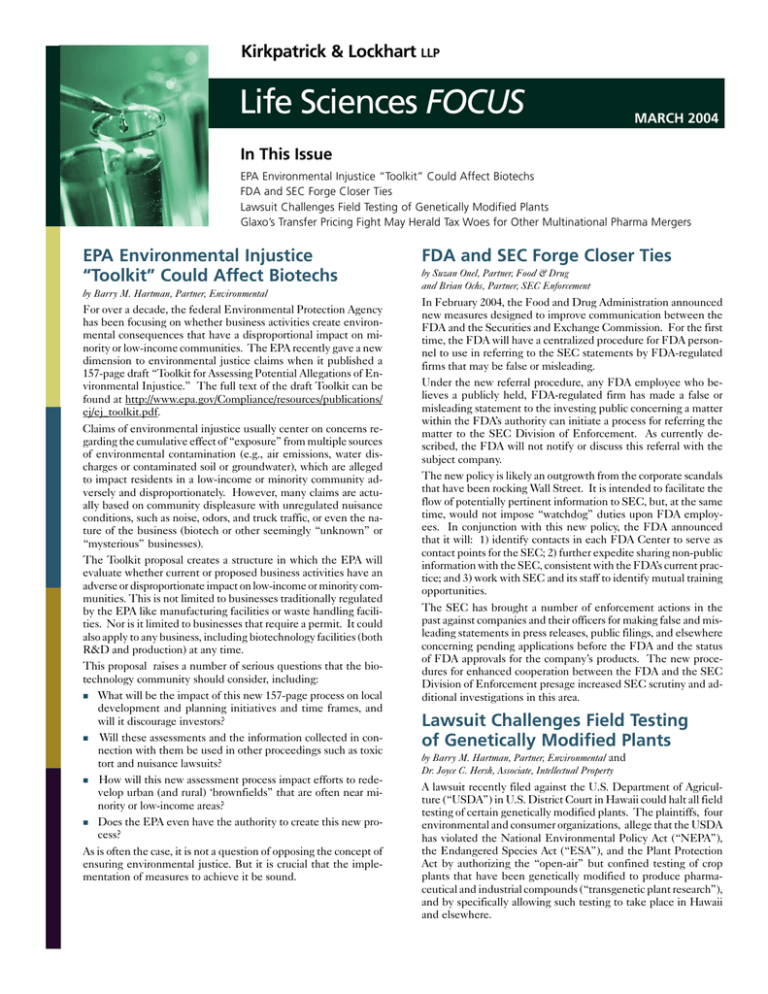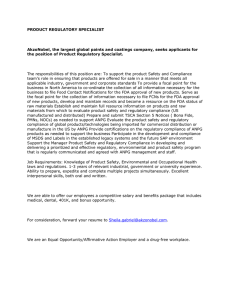
Kirkpatrick & Lockhart LLP
Life Sciences FOCUS
MARCH 2004
In This Issue
EPA Environmental Injustice “Toolkit” Could Affect Biotechs
FDA and SEC Forge Closer Ties
Lawsuit Challenges Field Testing of Genetically Modified Plants
Glaxo’s Transfer Pricing Fight May Herald Tax Woes for Other Multinational Pharma Mergers
EPA Environmental Injustice
“Toolkit” Could Affect Biotechs
by Barry M. Hartman, Partner, Environmental
For over a decade, the federal Environmental Protection Agency
has been focusing on whether business activities create environmental consequences that have a disproportional impact on minority or low-income communities. The EPA recently gave a new
dimension to environmental justice claims when it published a
157-page draft “Toolkit for Assessing Potential Allegations of Environmental Injustice.” The full text of the draft Toolkit can be
found at http://www.epa.gov/Compliance/resources/publications/
ej/ej_toolkit.pdf.
Claims of environmental injustice usually center on concerns regarding the cumulative effect of “exposure” from multiple sources
of environmental contamination (e.g., air emissions, water discharges or contaminated soil or groundwater), which are alleged
to impact residents in a low-income or minority community adversely and disproportionately. However, many claims are actually based on community displeasure with unregulated nuisance
conditions, such as noise, odors, and truck traffic, or even the nature of the business (biotech or other seemingly “unknown” or
“mysterious” businesses).
The Toolkit proposal creates a structure in which the EPA will
evaluate whether current or proposed business activities have an
adverse or disproportionate impact on low-income or minority communities. This is not limited to businesses traditionally regulated
by the EPA like manufacturing facilities or waste handling facilities. Nor is it limited to businesses that require a permit. It could
also apply to any business, including biotechnology facilities (both
R&D and production) at any time.
This proposal raises a number of serious questions that the biotechnology community should consider, including:
n What will be the impact of this new 157-page process on local
development and planning initiatives and time frames, and
will it discourage investors?
n Will these assessments and the information collected in connection with them be used in other proceedings such as toxic
tort and nuisance lawsuits?
n How will this new assessment process impact efforts to redevelop urban (and rural) ‘brownfields” that are often near minority or low-income areas?
n Does the EPA even have the authority to create this new process?
As is often the case, it is not a question of opposing the concept of
ensuring environmental justice. But it is crucial that the implementation of measures to achieve it be sound.
FDA and SEC Forge Closer Ties
by Suzan Onel, Partner, Food & Drug
and Brian Ochs, Partner, SEC Enforcement
In February 2004, the Food and Drug Administration announced
new measures designed to improve communication between the
FDA and the Securities and Exchange Commission. For the first
time, the FDA will have a centralized procedure for FDA personnel to use in referring to the SEC statements by FDA-regulated
firms that may be false or misleading.
Under the new referral procedure, any FDA employee who believes a publicly held, FDA-regulated firm has made a false or
misleading statement to the investing public concerning a matter
within the FDA’s authority can initiate a process for referring the
matter to the SEC Division of Enforcement. As currently described, the FDA will not notify or discuss this referral with the
subject company.
The new policy is likely an outgrowth from the corporate scandals
that have been rocking Wall Street. It is intended to facilitate the
flow of potentially pertinent information to SEC, but, at the same
time, would not impose “watchdog” duties upon FDA employees. In conjunction with this new policy, the FDA announced
that it will: 1) identify contacts in each FDA Center to serve as
contact points for the SEC; 2) further expedite sharing non-public
information with the SEC, consistent with the FDA’s current practice; and 3) work with SEC and its staff to identify mutual training
opportunities.
The SEC has brought a number of enforcement actions in the
past against companies and their officers for making false and misleading statements in press releases, public filings, and elsewhere
concerning pending applications before the FDA and the status
of FDA approvals for the company’s products. The new procedures for enhanced cooperation between the FDA and the SEC
Division of Enforcement presage increased SEC scrutiny and additional investigations in this area.
Lawsuit Challenges Field Testing
of Genetically Modified Plants
by Barry M. Hartman, Partner, Environmental and
Dr. Joyce C. Hersh, Associate, Intellectual Property
A lawsuit recently filed against the U.S. Department of Agriculture (“USDA”) in U.S. District Court in Hawaii could halt all field
testing of certain genetically modified plants. The plaintiffs, four
environmental and consumer organizations, allege that the USDA
has violated the National Environmental Policy Act (“NEPA”),
the Endangered Species Act (“ESA”), and the Plant Protection
Act by authorizing the “open-air” but confined testing of crop
plants that have been genetically modified to produce pharmaceutical and industrial compounds (“transgenetic plant research”),
and by specifically allowing such testing to take place in Hawaii
and elsewhere.
Plant research has become increasingly contentious over the years.
Activism against genetically modified plants in Europe has grown
to the point where protests and boycotts are now commonplace
against parties involved in agriculture, regulation, and food processing, distribution and sale. Similar incidents are beginning to
occur here in the U.S., and although isolated at present, are likely
to increase, given the international outlook of the activist organizations.
The implications of the lawsuit against the USDA are unclear
but potentially significant. Among other things, it is uncertain
what position various federal agencies will take with respect to
the assertions that such field testing activity comes within the
scope of NEPA and ESA. While the USDA may believe it has
complied with NEPA and ESA, the Fish and Wildlife Service,
which is responsible for implementing the ESA, may have a different view. Similarly, the Environmental Protection Agency,
which has been asserting expanded jurisdiction over new antimicrobial substances (see K&L Life Sciences FOCUS, November
2003), may have a differing view as well. The White House
Council on Environmental Quality, which has overall responsibility for agency compliance with NEPA, also may weigh in.
Parties who do business in this area, or who intend to, may find
it strategically advantageous to consider participating in this litigation, or making their views known through appropriate channels.
it reflects, in GSK’s view, tax treatment inconsistent with that the
IRS accorded SmithKline Beecham prior to the merger; and
n it rejects a ruling of the United Kingdom’s tax authority supporting
GSK’s position that it owes no further taxes to the United States
for the period and products in question.
The transfer-pricing issue arises when a multinational company allocates taxes on profits derived from manufactured products between
the United States and other countries.
For example, the manufacturer in the UK may sell finished products
or components to its US marketing subsidiary at a relatively high price,
thereby suppressing profit margins subject to US income tax. The
issue is the elusive one of determining what is the proper arm’s-length
or comparable price under the IRS’s transfer-pricing regulations, a
particularly difficult analysis where proprietary products and technology are involved. In the merger setting, potentially large but latent
tax issues of this kind are difficult to unearth in normal due-diligence
undertakings unless already raised by the taxing authority.
Prior to GSK’s challenge to the IRS assessment, there had been little
controversy over transfer pricing over the past few years. However,
given the number of recent mergers among the top twenty global
pharmaceutical companies—not to mention similar upcoming business combinations rumored in the marketplace—it is not inconceivable that other post-merger pharmaceutical powerhouses presenting
the same fact pattern may pique the interest of the IRS.
n
Glaxo’s Transfer Pricing Fight May
Herald Tax Woes for Other
Multinational Pharma Mergers
Please visit our website at www.kl.com, for more
information on the following upcoming life sciences
events in which attorneys from K&L are participating:
Suzan Onel: “Food Allergens: Thresholds, Labeling,
Manufacturing, and Consumer Issues47th Annual Conference
of the Food & Drug Law Institute, April 14-16—Washington DC
by Walter G. Van Dorn, Of Counsel, Tax,
and Eileen Smith Ewing, Partner, Corporate/Transactional
The $2.5 billion transfer pricing claim by the Internal Revenue
Service (IRS) against GlaxoSmithKline (GSK) is relevant to other
global pharmaceutical companies for three reasons:
n it involves legacy products of SmithKline Beecham sold prior
to that company’s merger with Glaxo Wellcome in 2000;
Dirk Michels: “Life Sciences Companies—Doing Business
in the United States”—CTI Startup Venture Day–Swiss
Commission for Technology, April 20—Zurich, Switzerland
James P. O’Hare, Jeffrey B Ritter, and Robert J. Sherry:
“Homeland Security: Venture Capital Investment and Business
Growth Opportunities”—Kirkpatrick & Lockhart 2004
Homeland Security Conference, April 29—Burlington, MA
For more information
K&L’s interdisciplinary Life Sciences Practice Group is a nationwide network of lawyers experienced in solving the complex legal and regulatory issues facing our pharmaceutical, biotechnology, health care and medical device clients. Practicing in areas as
diverse as corporate and securities, intellectual property, food and
drug, regulatory compliance, litigation, environmental and venture capital, we apply cutting-edge technological and business
savvy to the rapidly evolving life sciences industries.
The national contacts for K&L’s interdisciplinary Life Sciences
team are listed below. We invite you to contact one of them if you
have any questions or to learn more about our practice.
Marc H. Auerbach
Eileen Smith Ewing
Christine R. Ethridge
Ruth E. Granfors
Barry M. Hartman
Lorraine Massaro
Dirk Michels
Suzan Onel
Stephen A. Timoni
305.539.3304
617.951.9227
412.355.8619
717.231.5835
202.778.9338
212.536.4043
415.249.1022
202.778.9134
973.848.4020
Eileen Smith Ewing: “Intellectual Property Perspectives
on RNA Interference”—RNAi-2004-Boston Annual
Meeting, May 4—Boston, MA
Suzan Onel: “Patent Protection for Medical Devices:
FDA Regulation”—Minnesota Continuing
Legal Education, May 17—Minneapolis, MN
Gary N. Sutton: “Field of Use Licensing” 2004 Eastern
Regional Meeting, Association of University
Technology Managers,—May 25-27—Charleston, SC
Dirk Michels: “Importance of Start-Ups as a Source of
Innovation for Established Players in Pharma and
Industrial Biotech”—2004 Annual Meeting, Biotechnology
Industry Organization, June 6-9—San Francisco, CA
mauerbach@kl.com
eewing@kl.com
cethridge@kl.com
rgranfors@kl.com
bhartman@kl.com
lmassaro@kl.com
dmichels@kl.com
sonel@kl.com
stimoni@kl.com
K&L is the exclusive law firm sponsor of BioSwap, a non-profit
initiative to facilitate global partnering in the life sciences in the United
States, Europe, and Australia-Asia. BioSwap will host an international
partnering meeting on June 5, 2004 in San Francisco, CA, providing
attendees networking opportunities and one-on-one meetings with
investors. Visit www.bioswap.com for more information.
This publication/newsletter is for informational purposes and does not contain or convey legal advice. The information herein should not be used or relied upon in
regard to any particular facts or circumstances without first consulting a lawyer.
BOSTON
www.kl.com
© 2004 KIRKPATRICK & LOCKHART LLP. ALL RIGHTS RESERVED
■
■
DALLAS
■
HARRISBURG
LOS ANGELES
■
MIAMI
■
NEWARK
■
NEW YORK
■
PITTSBURGH
■
SAN FRANCISCO
■
WASHINGTON




